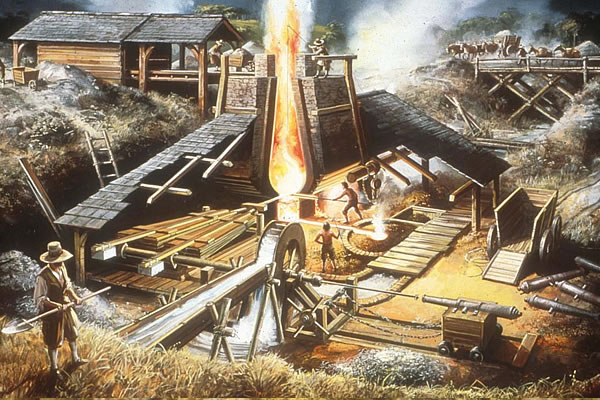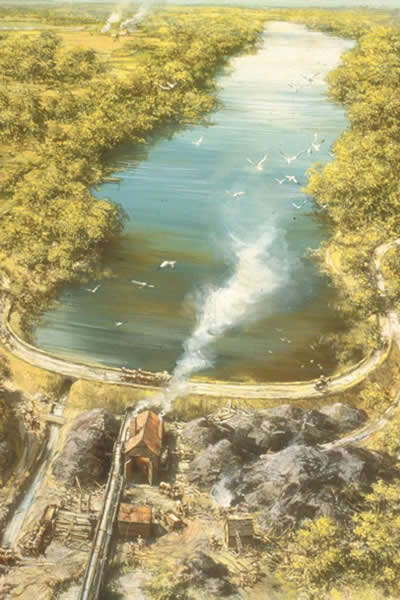Horsmonden Furnace

The largest Wealden iron works
Horsmonden was one of the centres of the old Wealden ironworking region and Furnace Pond is one of the largest and finest of the artificial lakes made to provide water power for the great hammers. Furnace Pond has an area of 30 acres and a spillway. The dam across the valley is some 140 yards in length with the head available being some 30 feet.
The mill wheel is no longer there, although the water still cascades over the spillway steps and the circular basin at the bottom in which the wheel used to turn is still there.
At its height, the Horsmonden Furnace employed two hundred men in making great guns for the Army and Navy.
The reason Horsmonden was a good location for an iron foundry was the availability of water, iron and wood, as well as access to Chatham Dockyards via Yalding and the River Medway.
Beginnings

The Horsmonden Furnace was first mentioned in 1574, when the owner was Thomas Bartell or Brattle.
In 1579 it was leased by Henry and Thomas Darrell to Thomas Dyke, with Brattle having an interest in the property.
Thomas Johnson era
In 1588 the furnace was leased by William Ashburnham and sub-leased to Thomas Johnson, a gunfounder.
Several of Thomas Johnson’s cannons have been found: one excavated in Sluis, a former harbour on the Flemish-Dutch coast; one on the ramparts of Fort of Santa Catarina in Brazil and one on the walls of Londonderry.
Some letters referred to January-February of 1595 when there was a threatened attack on the furnace and ironworks at Horsmonden, belonging to the Queen’s gunfounder, Thomas Johnson.
The furnace is referred to as ‘Sharndon Furnace’. The clothiers were opposed to building of ironworks because they used up fuel and water power. Also mentioned was a Parliamentary bill bought forward for the demolishing of all ironworks within seven miles of Cranbrook, the centre of the Wealden cloth trade, which would have just affected Horsmonden.
In 1596 the furnace was owned by Sir Thomas Waller, and leased to John Iden and Robert Pothill.
The Browne era
The furnace was leased by Thomas Browne in 1604 and later transferred to his son, John Browne, who succeeded from his father the office of King’s Gunfounder from 1619 to 1681. Some 200 men were employed at the furnace in 1613.
Dutch exports
The principal foreign buyers of English guns were the Dutch, during the war of liberation from Spain in the later part of the sixteenth century. Purchases by the Dutch continued in the seventeenth century with the expansion of the Dutch Navy and Holland emerging as a principal maritime power.
No effort was spared by the Dutch to procure cast-iron guns manufactured in England; for example, in the years 1615 to 1618 they were purchasing half the produce of John Browne’s gunfoundry at Horsmonden in Kent. He employed two hundred men (a very considerable number in this early period), to use his own words, ‘the Dutch havinge bargained with him to take of all that the English doe not buy’; the number of guns ready for transportation from the works to Holland amounted to six hundred during those years.
Frequently Dutch merchants such as Ludolph Engelstedt and Giles de Vischer, in 1594 to 1596 acting as special agents for their Government, stayed in England to buy cast-iron cannon and to procure export licences from the English Government.
Monopoly
John Browne had the monopoly on manufacture of Royal guns and in 1625, after the outbreak of the Spanish War, his foundry made five hundred guns for the British ships.
Royal visit
King Charles I visited the foundry in 1638 to watch a cannon being cast – a bronze four-pounder, forty-two inches long, now preserved in the White Tower at the Tower of London.
Civil War
The civil war which started in 1642 gave a new impetus to gunfounding in the Weald. Twenty-six furnaces, referred to in 1653, were engaged in the production of guns and shot for Charles I, and so were two furnaces (Cannop and Lydbrook) in the Forest of Dean. In 1664, eleven furnaces operating in the Weald made cannon and bullets for the Dutch war, and thirteen further furnaces were restored and stocked. The most important gun-founders in the Weald during the seventeenth century were the Brownes of Horsmonden.
Not long after the start of the civil war, John Browne found himself in trouble because despite his previous Royal patronage he sided with the Parliamentarians in the Civil War and would not make guns for the Royalists.
High prices
The high price of English guns was no deterrent to continental purchasers, since they were well aware of their superior quality. This is reflected in their frequent attempts to induce English founders to work abroad, and to obtain cannon by illegal trade and bribery, if they could not be procured from English founders authorised to sell abroad.
Moreover in 1598, an Englishman wrote from Spain that all seafaring men agree ‘that they never see cast ordnance of iron but such as is made in England’. More convincing than the demand from the continental market is the term ‘after the English fashion’ applied to the casting of iron guns in German Westfalia in 1592, and in Sweden in 1600. This term clearly signifies that English gunfounding was the model for their colleagues on the Continent.
Foreign competition
Naturally foreign gunfounders could not rest until they had found out what the ‘English fashion’ of casting was. The first, who in 1620 claimed to have succeeded by discovering the secret on journeys they made in England and from iron-merchants they met on the Continent, were two citizens of Namur, in Belgium, Henri de Harscamp and Guillaume de Moniot. They erected furnaces in the vicinity of Namur to put their discovery into practice. This was the starting point of a competition which intensified when shortly afterwards gunfounding was introduced from Liege into Sweden. The superior Swedish ore made it possible to produce guns which finally ousted the English cast-iron cannon from the Continental market.
Yalding was a main shipment point for the cannons manufactured here, where the cannons were shipped via the River Medway to the naval base at Chatham.
John Browne death and beyond
John Browne died in 1651 and his business was passed on to his grandson also named John. Since he was too young to run the business, his uncles George Browne and Thomas Foley ran it on his behalf. With the Restoration of Charles II, George Browne took over the main part of the gunfounding business, reclaiming the family title of Royal Gunfounder. In 1670 George Browne handed back the business to his nephew John Browne III to run. John died a few years later and his widow eventually was declared bankrupt. In 1683 the last bronze piece was cast under the Brownes.
Furnace closure
The famous foundry finally closed in 1685 when the manufacture of iron moved to the Midlands with their coal fired plants. In 1744 there was a boring mill run by one Harrison at the site.
William Benge
In 1688 William Benge is gunfounder at Horsmonden.
Today
You can visit the site of Horsmonden Furnace and see Furnace Pond and the spillway. It is still remembered both by The Gun and Spitroast, formerly The Gun, named after it when it became an inn round about 1750, and also by the cannon carved on one quarter of the village sign.
Timeline
This timeline attempts to put into context the operation of Horsmonden Furnace as a gun foundry against related conflicts and political happenings of the era.
1574 – First mention of Horsmonden Furnace
1579 – Leased by Henry and Thomas Darrell to Thomas Dyke
1588 – Leased by William Ashburnham and sub-leased to Thomas Johnson, a gunfounder
1594-1603 – Nine Years’ War in Ireland
1595 – Threatened attack on furnace by clothiers
1596 – Owned by Sir Thomas Waller, and leased to John Iden and Robert Pothill
1603 – Elizabeth I dies. James I coronation
1604 – Leased by Thomas Browne
1609 – End of the Dutch Revolt and beginning of 12 Years’ Truce
1613 – 200 men recorded employed at the Horsmonden Furnace
1615 – John Browne increasingly takes control of the foundry from his father
1615-18 Dutch purchase half the furnace output of cannons
1619 – John Browne succeeds his father as King’s Gunfounder
1625 – James I dies. Anglo-Spanish war, 1625 part of the Thirty Years’ War
1626 – Charles I coronation
1627 – Anglo-French war, 1627-1629, part of the Thirty Years’ War
1637 – HMS Sovereign of the Seas is launched
1638 – King Charles I visits Horsmonden Foundry
1641 – Outbreak of the English Civil War 1641-1651
1645 – John Browne and his son were ordered by Parliament to be taken into safe custody but later released.
1649 – Charles I executed
1651 – John Browne dies
1652 – First Anglo-Dutch War 1652-1654
1654 – Anglo-Spanish War fought between the English Protectorate of Oliver Cromwell and Spain 1654-1660
1658 – Oliver Cromwell dies
1660 – Restoration of the Monarchy
1665 – Second Anglo-Dutch War 1665-1667
1672 – Third Anglo-Dutch War 1672-1674
1680 – Fourth Anglo-Dutch War 1680-1684
1683 – The Brownes cast their last bronze piece.
1685 – Horsmonden Furnace closes. Charles II dies. John Browne ceases to be King’s Gunfounder.
1688 – William Benge is gunfounder at Horsmonden.
1744 – A boring mill run by a Harrison operates at the site
Useful links and sources
Iron guns ‘After the English Fashion’
Sources
Letters and copy letters about a threatened attack on a furnace and ironworks at Horsmonden
Illustrations by Mike Codd © West Sussex County Council
[summary-child-pages]